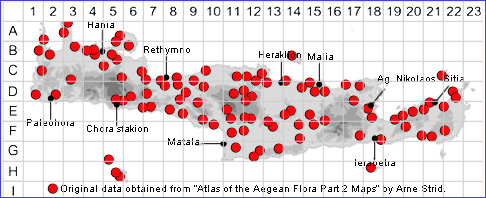
SPECIES DESCRIPTION
HEDYPNOIS RHAGADIOLOIDES
Including subsp. rhagadioloides and subsp. tubaeformis. (See footnote)
Family and Genus:- See- COMPOSITAE
Common Names:- Hedypnois, Variable hawkweed.
Meaning:- Hedypnois (Gr) Sweet breath.
Rhagadioloides (L) Divided. (the inner achenes falling early but the
outer elongate and persist).
General description:- A variable low to short, somewhat hairy annual.
Stem:-
1) 3-45(-60) cm, more or less hairy, slender, spreading to ascending, branched.
Leaves:-
1) 5-180(-250) x 2-25(-35) mm, mostly narrowly elliptical to oblanceolate, entire to
deeply dentate or lobed.
a) basal, usually with winged petioles.
b) cauline, usually sessile.
Flowers:-
1) Capitula, dull golden-yellow, 13-16mm, solitary to numerous.
2) Peduncles, more or less thickened.
3) Involucre, 7-10·5 x 3-11 mm.
4) Bracts, narrowly linear-lanceolate, more or less acute, the inner usually partially
enclosing the outer achenes and strongly incurved in fruit.
5) Receptacle, without scales.
Fruit:-
1) Achenes, 5-7·5 mm, often narrowed near apex, with minute, rigid hairs;
a) outer achenes, incurved.
2) Pappus, of the outer achenes usually a corona, that of the inner, of narrow, long-
aristate scales.
Key features:-
1) Involucral bracts, strongly incurved in fruit.
2) Pappus, of outer achenes usually a corona.
Habitat:- Dry habitats, cultivated, fallow and waste ground, sand-dunes, roadsides,
open dry shrubby vegetation 0-500(-1100) m.
Distribution:- Widespread across the Mediterranean. Widespread distribution and
occurrence across Crete. An introduced weed in parts of the Southern Hemisphere
and North America.
Flowering time:- Feb-July.
Photos by:- Fotis Samaritakis
This species is common throughout the Aegean area,very variable and has often
been subdivided. Autogamy and paitial apomixis has produced a complex morpho-
logical variation, but there appears to be no geographical pattern. Nordenstam
(1971) found a correlation between morphology and chromosome number: plants
with compact habit and distinctly swollen peduncles, often called subsp.
tubaeformis (Ten.) Hayek (syn.: H. tubaeformis Ten.), have 2n = 16, whereas lower
chromosome numbers (2n = 8 to 2n = 14) were found in plants morphologically
matching subsp. cretica (L.) Hayek (syn.: H. cretica L.) or subsp. monspeliensis
Nyman (syn.: H. monspeliensis Willd., nom. illeg.). Elsewhere this correlation
appears to be less clear, and for the time being H. rhagadioloides is best kept as a
single, variable species. 1)
1) "Atlas of the Aegean Flora" Book1, Arne Strid 2016.
